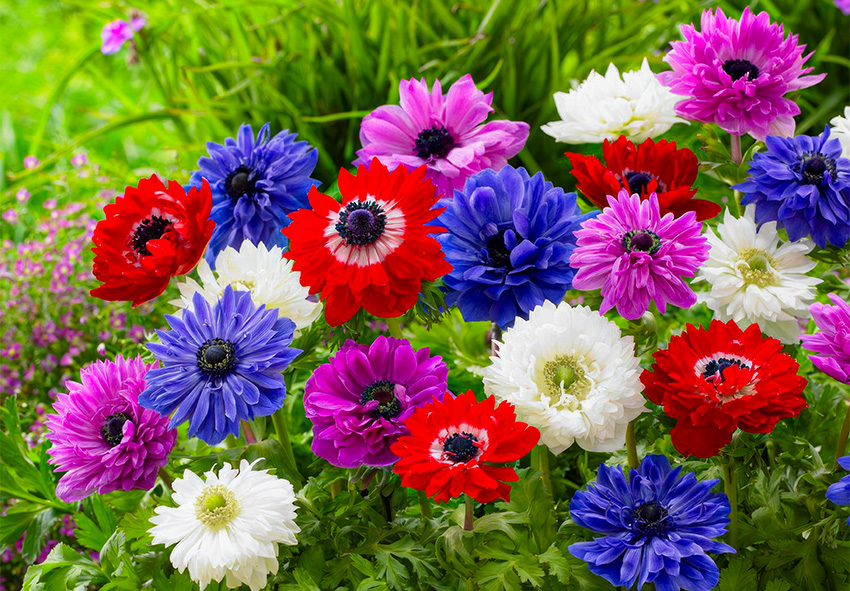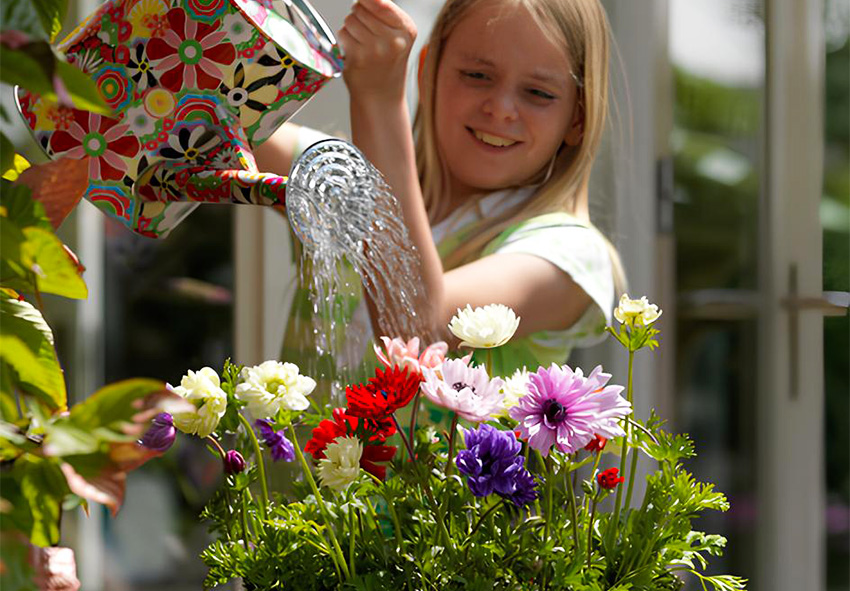Anemones are beloved for their vibrant colors, delicate petals, and ability to bring life to gardens throughout the year. While they are relatively low-maintenance, their needs change with the seasons, making proper care essential for healthy blooms. This guide explores seasonal care for anemones, from spring growth to winter protection, ensuring they thrive in your garden year after year. Our gardening blog is a perfect place to find all the information you need!
Understanding Anemones and Their Growth Cycle

Anemones are unique because they grow from corms, small bulb-like structures that store energy for the next season. Depending on the variety, they may bloom in spring or fall, creating multiple opportunities for seasonal interest. By understanding their life cycle, you can better plan planting, maintenance, and protection strategies.
What Makes Anemones Unique?
Unlike many flowering plants, anemones can adapt to different climates and provide blooms across multiple seasons. Their versatility makes them a favorite among gardeners looking for both spring and fall color. Each variety has slightly different care needs, so choosing the right type for your region is essential.
Anemone Bulbs (Corms) and Seasonal Behavior
Knowing how to plant anemones is as important as knowing how to care for them. These plants grow from corms that enter a period of dormancy after blooming. This cycle allows them to survive winter or summer heat, depending on the variety. Proper handling of corms during these phases ensures strong regrowth in the following season.
Blooming Periods by Variety
Spring-blooming anemones like Anemone blanda offer early bursts of color, while Japanese anemones extend garden beauty into late summer and fall. Knowing the blooming period helps plan complementary planting. This also allows for continuous displays when paired with other perennials.
Spring Care for Anemones
Spring is the season of growth and bloom for many anemone varieties. Providing the right care now ensures strong flowers and healthy foliage. Attention to watering, feeding, and deadheading makes a big difference in the longevity of blooms:
- Encouraging Healthy Blooms: When new growth appears, provide balanced fertilizer to support strong stems and vibrant flowers. Remove weeds around your anemones to reduce competition for nutrients. Consistent care during this stage leads to abundant and colorful displays.
- Proper Watering and Feeding Practices: Water your anemones regularly in spring, ensuring the soil stays moist but not waterlogged. A slow-release fertilizer applied early in the season supports vigorous growth. Avoid overfeeding, as this may result in more foliage than flowers.
- Deadheading and Extending Flowering: Remove spent blooms promptly to encourage continuous flowering. This prevents energy from going into seed production and redirects it to root and corm development. Deadheading also keeps the plants tidy and attractive in the garden.
Summer Care for Anemones
Summer care focuses on maintaining foliage and preparing plants for dormancy. For some types, summer can be a resting period where the foliage dies back. Protecting corms during this time helps them recover and recharge.
Managing Foliage After Flowering
Once blooms fade, allow the foliage to remain until it yellows naturally. This process allows corms to store energy for the next growing cycle. Cutting back too early may weaken the plant and reduce future flowering.
Watering Tips in Hot Weather
During summer, anemones need consistent moisture but dislike overly wet soil. Mulching helps retain soil moisture and keeps roots cool. In very hot climates, partial shade can prevent stress and keep the plants healthier.
Preparing Anemones for Dormancy
As the foliage dies back, reduce watering gradually to allow the corms to enter dormancy. This is a natural part of their cycle and ensures survival until the next season. Properly managed dormancy leads to stronger plants in the following year.
Fall Care for Anemones

Fall is planting season for many anemone varieties and a critical time for preparing beds. Careful soil preparation and protection set the stage for next year’s blooms. Fall-blooming varieties also need ongoing care to maintain late-season displays.
When and How to Plant Anemone Bulbs
Plant anemone bulbs in fall, about 2–3 inches deep, with spacing of 3–4 inches. Soak the corms overnight before planting to jump-start growth. This ensures quicker establishment and healthier flowers in spring.
Soil Preparation for Fall Planting
Loosen the soil and enrich it with compost or organic matter before planting. Well-drained soil prevents waterlogging, which can cause rot. Preparing the bed carefully increases the success rate of your anemones.
Mulching and Protection Before Winter
Apply a layer of mulch to protect corms from cold snaps. Mulch also regulates soil temperature and prevents weeds from sprouting. This extra protection ensures that your bulbs survive winter in top condition.
Winter Care for Anemones
Winter care depends on your climate and the variety of anemones. In mild areas, they may remain in the ground, while in colder climates, lifting and storing corms is necessary. Proper handling in winter protects them for the next growing season.
Overwintering in the Ground (Mild Climates)
In frost-free areas, anemones can safely overwinter in the soil. Mulching adds a protective layer and prevents damage from sudden cold spells. Keeping the soil lightly moist helps prevent the corms from drying out.
Lifting and Storing Corms (Cold Climates)
In regions with harsh winters, lift the corms after foliage dies back. Clean and dry them before storing in a cool, dark, and dry place. This method keeps the bulbs safe until it’s time to replant.
Preparing for Early Spring Growth
Check stored corms in late winter for signs of rot or damage. Discard unhealthy ones and prepare healthy corms for replanting. This ensures a strong start when spring arrives.
Fertilizing and Soil Management Throughout the Year
Consistent soil care and fertilization support healthy growth across all seasons. Anemones thrive in nutrient-rich, well-drained soil that supports both root development and blooming. Adjusting fertilizers seasonally maximizes plant health and flowering. Here are three main fertilization tips you may need:
- Best Fertilizers for Anemones: Balanced, slow-release fertilizers work best in spring, while phosphorus-rich options support blooming. Avoid excessive nitrogen as it encourages leaves at the expense of flowers. Organic compost is also an excellent choice.
- Adjusting Nutrients by Season: Feed lightly in early growth stages, then increase during bloom. After flowering, reduce fertilization to allow plants to prepare for dormancy. Adjusting nutrients ensures that energy is directed at the right stage of growth.
- Avoiding Common Soil Problems: Heavy clay or poorly drained soil often leads to rotting corms. Amend soil with compost or sand to improve structure. Regular soil checks help maintain the right balance for healthy growth.
Common Mistakes in Seasonal Anemone Care
Many gardeners unknowingly make mistakes that reduce flowering or damage corms. Avoiding these pitfalls ensures healthier plants and longer-lasting blooms. Awareness of common issues helps in taking preventive measures:
- Planting bulbs too deep or too shallow can hinder growth.
- Overwatering during dormancy often leads to corm rot.
- Neglecting winter protection risks bulb loss in cold climates.
Companion Planting and Design Ideas
Anemones look stunning when paired with other flowers, adding depth and variety to garden displays. Companion planting also helps fill gaps during off-bloom seasons. A well-designed garden maximizes seasonal color and texture. Choose best plants to pair with anemones by season:
- Spring-blooming anemones: tulips, daffodils, or hyacinths for layered displays.
- Fall-blooming anemones: asters and ornamental grasses.
Stagger bloom times by mixing early and late varieties of anemones. Add companion plants that flower in different seasons for nonstop interest. This approach keeps your garden vibrant throughout the year.
Plant anemones in clusters for a natural, meadow-like effect. Use them along borders, under trees, or in containers for versatility. Their wide color range allows them to fit into any design scheme.
Conclusion
Seasonal care for anemones is the key to keeping these beautiful flowers healthy and vibrant year after year. From planting bulbs in fall to protecting corms in winter and nurturing blooms in spring, each step ensures their success. By following these seasonal tips, you can enjoy dazzling displays of anemone flowers in every garden season!
Frequently Asked Questions (FAQs) about Seasonal Care for Anemones
1. How do I care for anemones in spring?
In spring, water regularly to keep soil evenly moist and apply a balanced fertilizer to support healthy growth. Deadheading faded blooms encourages continuous flowering. Providing consistent care in spring ensures vibrant colors and stronger plants for the season.
2. Should I water anemones during summer dormancy?
During summer dormancy, gradually reduce watering as the foliage dies back. Overwatering at this stage can cause corms to rot. Instead, allow the soil to remain lightly moist while protecting bulbs with mulch in very hot climates.
3. Can I order anemone bulbs from your online store?
Yes! We offer anemone bulbs for purchase through our online store Dutch-bulbs.com. Simply browse our store, choose your favorite Anemone varieties, and follow the easy ordering process to have them delivered to your doorstep, ready for planting.
4. How do I protect anemones in winter?
In mild climates, anemones can overwinter in the ground with a protective mulch layer. In colder regions, lift and store corms in a cool, dry place after the foliage dies back. This prevents frost damage and keeps bulbs ready for replanting in spring.
5. What are common mistakes in seasonal care for anemones?
Common mistakes include planting bulbs too deep or too shallow, overwatering during dormancy, and failing to protect corms in cold climates. Another error is removing foliage too early, which prevents corms from storing enough energy for the next season’s blooms. Avoiding these ensures healthier plants.
Published: 19.09.2025

